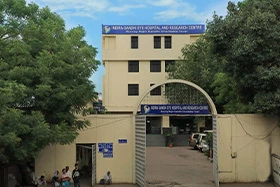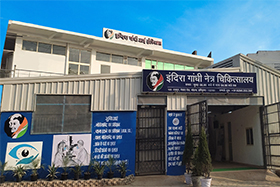- Centurion Phacoemulsification Vision System
- Infiniti Phacoemulsification Vision System
- Zeiss Lumera Operating Microscopes
- A Scan Biometry: Zeiss IOL Master 700
- B Scan Ultrasonography
- Email: enquiry@indiragandhieyehospital.com
- Call: 01242710271
Specialties
Cataract Surgery in Gurgaon
The Cataract and IOL Microsurgery Department at Indira Gandhi Eye Hospital, renowned as the best eye hospital in Gurgaon, provides a comprehensive range of state-of-the-art treatments, setting a benchmark in ophthalmic care in Northern India. Our department prides itself on a cadre of seasoned and distinguished surgeons. These experts are adept in handling all facets of advanced cataract microsurgery, making us a leading choice for cataract surgery in Gurgaon.
Our department is not just a center for patient care but also a hub of educational excellence. It serves as a prominent cataract surgery training center, where we have imparted advanced surgical skills to a multitude of ophthalmologists. This training encompasses various modalities of cataract surgery in Gurgaon, ensuring that the next generation of eye surgeons is well-versed in the latest techniques and best practices.

Furthermore, our commitment to innovation and continuous learning ensures that we stay at the forefront of ophthalmic advancements. By integrating cutting-edge technology and research into our practice, we strive to offer our patients the most effective and minimally invasive treatment options available today.
Patients who choose Indira Gandhi Eye Hospital for their cataract needs can expect not only exceptional medical care but also a supportive and informative environment. Our team is dedicated to guiding patients through their journey to improved vision, offering personalized care at every step. This approach has established us as a leader in eye care and cataract surgery within Gurgaon and beyond.
Technical set up
- Keratometer
- Pentacam: Corneal topography
- Retinal Acuity Meter (RAM): Macular function
- Pachymetry
- I TRACE Aberrometry
- FD OCT
- Anterior segment digital photography
- Dry eye disorders estimation
- Specular microscopy
Treatment available
The department offers to the efficient diagnosis and management of a wide range of diseases:
- Senile Cataracts
- Developmental Cataracts
- Posterior Polar Cataracts
- Traumatic Cataracts
- Subluxated and Dislocated Cataracts: Cionni ring, Segments and CTR implantation
- Complicated cataracts with uveitis
- Complicated cataracts with glaucoma
- Combined Cataract and Retina Surgeries
- Secondary IOL implantation
- Management of Aphakia
- Cataracts with Microcornea and Colobomas of Iris, Lens and Retina-choroid
- Refractive errors management with CLE
- Iris-Fixated Intraocular lenses
- Aniridia IOLs
- Pupillary Reconstruction surgeries
- Management of Refractive errors
Procedures or surgeries
The department has an array of surgeries to offer and provide most recent advances in the field of Cataract surgery which include:
Topical Microincision Cataract Surgery (MICS) with Foldable MULTIFOCAL / TRIFOCAL / TORIC AND TORIC MULTIFOCAL Intra Ocular Lens Implantation: Cataract surgery is performed without injection by the latest & most advanced Centurion Phacoemulsification vision system from a 2.2 mm incision and a foldable Multifocal/ Trifocal/ Toric / Toric Multifocal lens implanted .
Topical Microincision Cataract Surgery (MICS) with Foldable EDOF Intra Ocular Lens Implantation:Cataract surgery without injection by Centurion Phacoemulsification vision system from a 2.2 mm incision and a foldable Extended Depth Of Focus (EDOF) lens implanted
Traumatic Subluxated Cataracts:Cataract surgeries with inadequate Zonular support ; Cionni Ring, Segments or Capsular Tension Rings are implanted with Foldable IOLs. Wound exploration and reconstruction in cases of Penetrating trauma with cataract.
Management of Aphakia with Secondary IOLs: Scleral Tuck IOLs, Iris Fixated IOLs
Secondary Management of Surgical complications in cases referred from elsewhere: Our Surgical team has special expertise in the management of surgical complications of patients referred from outside
Small Incision Sutureless Cataract Surgery: An excellent quality surgery in high volumes of Outreach community cases
The department is equipped with microbiological and histopathological evaluations: of diseases of external eye diseases




